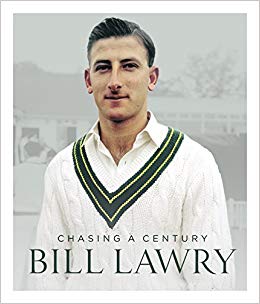Chasing a Century – Bill Lawry
Martin Chandler |Published: 2018
Pages: 210
Author: Proietto, Alison (Editor)
Publisher: Hardie Grant
Rating: 4 stars

The initial draft of this review began with two complaints, albeit only one of them concerns the book itself, and then only indirectly. The first relates to the sort of book this is, or more accurately what it is not. There are a few soundbites from Bill Lawry dotted around, but the book is no sort of an autobiography nor, though Lawry is most certainly the subject, can it by any stretch of the imagination be described as a biography. This is not good, in the sense that if any man still alive deserves to have his life properly written up it is Lawry. At the moment all we have is Run Digger, a not particularly appealing ghosted autobiography that was published in 1966.
Why does Lawry need a biography? Some would say 67 Test appearances of itself justifies such a book, but in addition Lawry was an Australian captain whose international career ended in somewhat controversial circumstances. Beyond that he was a popular commentator for more than forty years, thus a man who all told spent more than sixty years in the game. No doubt that book will arrive one day, but in the meantime Chasing a Century is an excellent piece of work in its own right.
I will explain why the book is such a good one, but its quality brings me on to my second complaint, although in part I now have to resile from that. As a collection of photographs and of the writings of a variety of individuals Chasing a Century is the sort of book that needs a good editor, who you would then expect to be credited. In fact at the eleventh hour I discovered there is, tucked away in tiny print on the copyright page, a short list of credits in a tiny font in which a lady whose name is unfamiliar to me, Alison Proietto, is confirmed as editor. She has done an excellent job, and surely deserves her name to appear, at the very least on the book’s spine, but better still on the front of the dust jacket.
Chasing a Century is divided into six sections. Those dealing with Lawry’s early life, grade career and state cricket are modest in length. The longest section is entitled Playing for Australia, the next in length Captain, with the book closing with a chapter on Lawry the Commentator.
The contributors are many and varied. Test teammates like Neil Harvey, Keith Stackpole, Bobby Simpson and Garth McKenzie each appear several times. Some of Lawry’s grade teammates at Northcote and St Kilda write for the book, and writers and journalists relate their impressions and memories of Lawry as well. Such is the nature of the beast that these contributions are almost all positive, and the hagiographical nature of such writing, whilst interesting to read, does highlight the desirability of a book with the more balanced and analytical approach that an accomplished biographer would bring to his or her task.
The real magic in Chasing a Century however is not in the text, but in the 92 photographs that grace its pages. Without exception these are exceptionally well produced, and all are substantial. The book is a large octavo in size and a number of the images cover two pages, and many more at least one full page. The result is a pictorial record of cricketing and social history. Were ties really that skinny in the 1960s? and did Lawry really appear to be so young for so long?
Some of the images are of the game being played, and inevitably a goodly number are posed, if not always formally so then they were taken when Lawry at least knew he was being snapped. Best of all are the unguarded moments; Lawry with Garry Sobers, and Lawry at Lord’s in 1980 with a long line of other Ashes captains at the centenary Test being two that are particularly compelling.
For a batsman famously described as plying his trade like a corpse with pads on Lawry’s persona in the commentary box was something of a revelation. All the photographs of Lawry in the closing section of the book, bar two, show the trademark smile. One exception, in keeping with Lawry’s innate modesty, is the rather pensive look on his face as he is inducted into the Cricket Australia Hall of Fame, and the other a haunting image of a clearly moved Lawry paying his respects at the SCG to his recently deceased colleague, Tony Greig.
Whilst Chasing a Century is not quite what I expected, nor even necessarily what I wanted it to be, it is still a worthy addition to the literature of the game and is recommended. It has whetted my appetite for a biography, and I can’t help but think that perhaps Lawry’s former Australian teammate, Ashley ‘Rowdy’ Mallett, might be just the man to write it.






Leave a comment